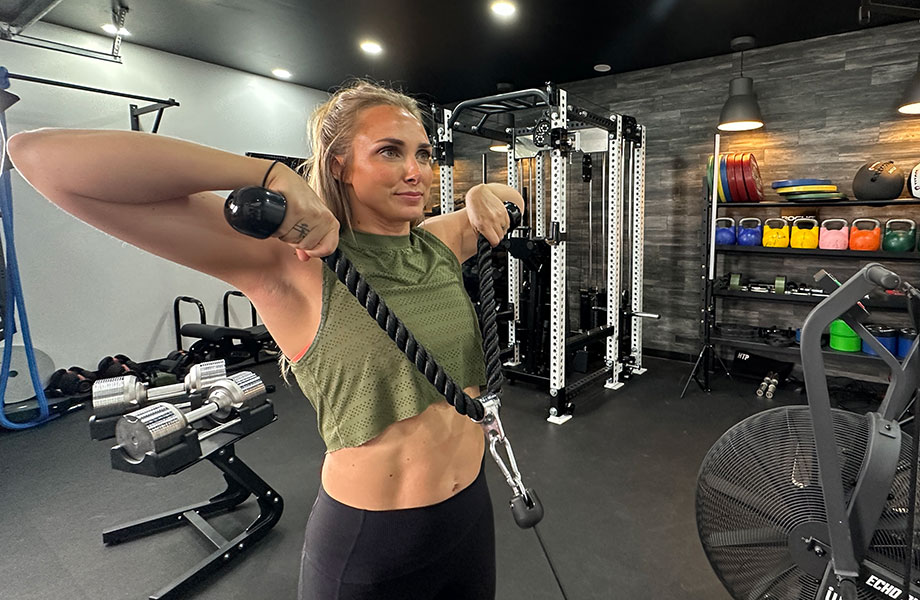We test and review fitness products based on an independent, multi-point methodology. If you use our links to purchase something, we may earn a commission. Read our disclosures.
Many lifters and fitness enthusiasts alike strive to build muscle, strength, and stability in their shoulders. The most popular way involves performing repetitions of shoulder exercises with free weights, like barbells, dumbbells, and kettlebells, to provide activation and inspire hypertrophy.
Don’t get us wrong; free weights are totally a viable way to sculpt powerful delts, traps, and other upper body muscles, but it’s not the only way.
The cable machine offers an abundance of movements that’ll spruce up your workout routine. Cable shoulder workouts are effective and efficient, and make an excellent alternative to traditional resistance training.
So, leave the free weights on the rack, and try out some of the best cable shoulder exercises for your next shoulder training sesh!
Your Deltoids, Explained
There are many muscle groups in your shoulders, ranging from the smaller levator scapulae and rotator cuff muscles to the massive trapezius, which spans from the base of your neck, across your shoulders and upper back, and down to the mid-back region.
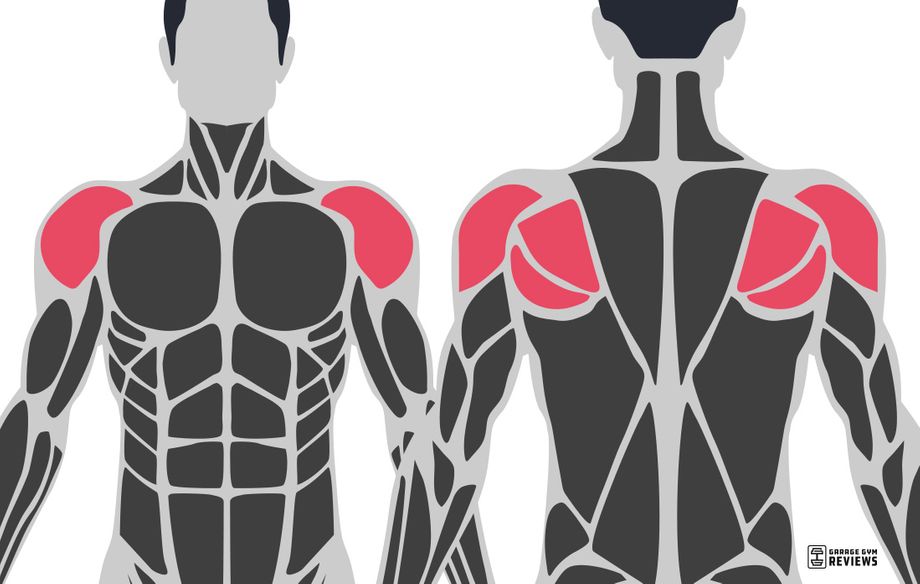
For our shoulder workout, we’ll be concentrating on the deltoids1.
“Our deltoids are important,” says Kate Meier, CPT. “They stabilize our shoulder joints and allow us to move our arms in many different directions.”
Well-sculpted deltoids also offer aesthetic appeal, giving our shoulders that classic rounded appearance that’s common in athletes and bodybuilding champions.
If you’re interested in building stronger, well-rounded delt muscles, you’ll need to pay special attention to each of the three heads of the deltoids. These are the anterior deltoids (or front delts), the posterior deltoids (or rear delts), and the lateral deltoids, also called the medial or side delts.
RELATED: The Best Deltoid Exercises
How to Target Delts With Cables
A 2020 study published in the Journal of Human Kinetics2 compared how different shoulder exercises affected muscle activation of the deltoid muscle. The results found that the exercise selection and movement pattern played a significant role in which portion gets the most impact.
“How you move your arm determines which portion of the deltoid works hardest,” says Kate. “Moving your arm in front of the body, for example, emphasizes the front of your shoulders, or anterior deltoid, while moving your arm laterally hits the lateral deltoid, and so on and so forth.”
Thankfully, cable machines are endlessly versatile. You can adjust the pulley height, making it possible for the resistance to come from above, below, or directly behind our shoulders.
The direction you are facing during the exercise will also play a role, as facing the machine, facing away, and standing with the machine at your side all produce different angles, each of which will have a different effect on the deltoid muscle.
RELATED: The Best Shoulder Workouts With Dumbbells
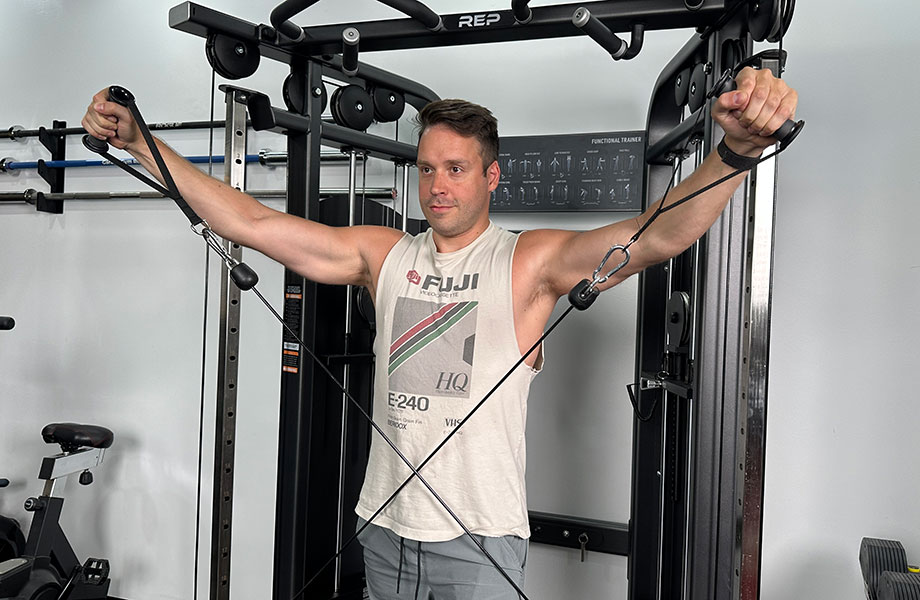
Shoulder Exercises With Cables
Placement is key when performing cable machine shoulder exercises. Too close, and you’ll diminish the effect of the exercise; too far, and you’ll become off balanced.
“Get far enough away from the machine that you feel a little pull from the handle or attachment, but you still feel you’re grounded and stable,” adds Kate. “Consider going lighter until you get the placement down, then scale up from there.”
Cable Single-Side Lateral Raise
Part of deltoids targeted: Lateral, anterior, posterior
How to do it:
- Set the cable pulley to the lowest setting. Grab the handle with your right hand, keeping your left shoulder facing the machine, and step away to create tension.
- Raise your right arm laterally until it’s at shoulder level, maintaining a slight bend in the elbow, then slowly lower it back to the starting position.
- Repeat as needed, then switch sides.
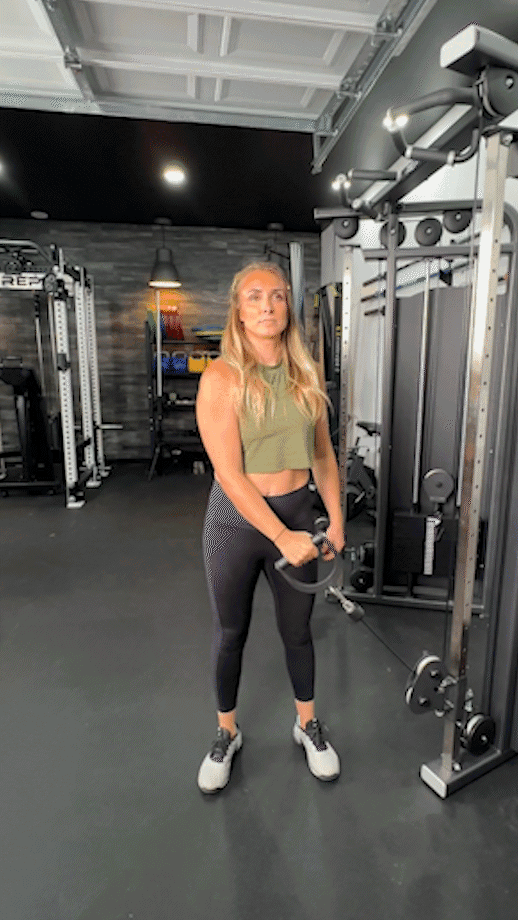
Cable Shoulder Press
Part of deltoids targeted: Anterior, lateral, posterior
How to do it:
- Set the pulley to the lowest setting, then grab the handles with both hands, bring them to shoulder height, and take a step away from the machine.
- Push the handles directly overhead as you would for a barbell overhead press, squeezing your shoulders at the top of the movement.
- Slowly lower the handles back down, controlling their descent.
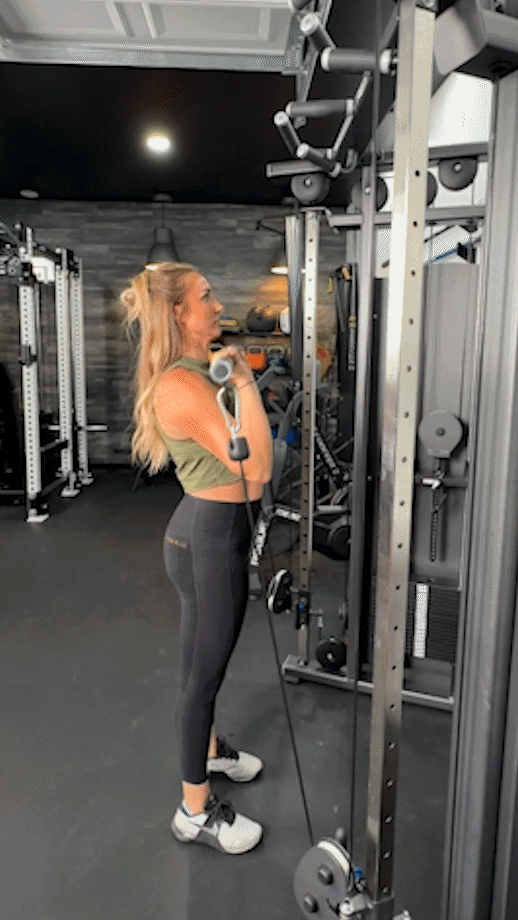
Cable Crossover
Part of deltoids targeted: Anterior
How to do it:
- Set the pulleys to the highest position, grab the handles, and step forward to enter a staggered stance. Keep your arms wide so you feel a stretch in your chest.
- Bring your hands together to your midline, just as you would for a chest fly, then allow one arm to cross over the other. Squeeze your pecs and hold the position.
- Slowly bring the handles back to the starting position.
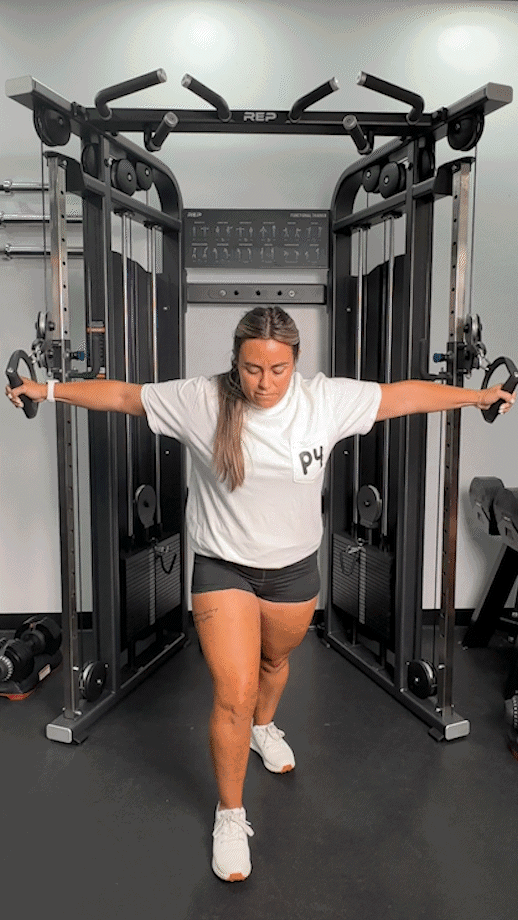
Cable Front Raise
Part of deltoids targeted: Anterior
How to do it:
- Set the pulley to the lowest position, grab the handles, then step forward and hold them in front of your body with your elbows slightly bent.
- Keeping your arms extended and your palms facing the floor, raise your arms straight out and up until they are shoulder level.
- Slowly return to the starting position.
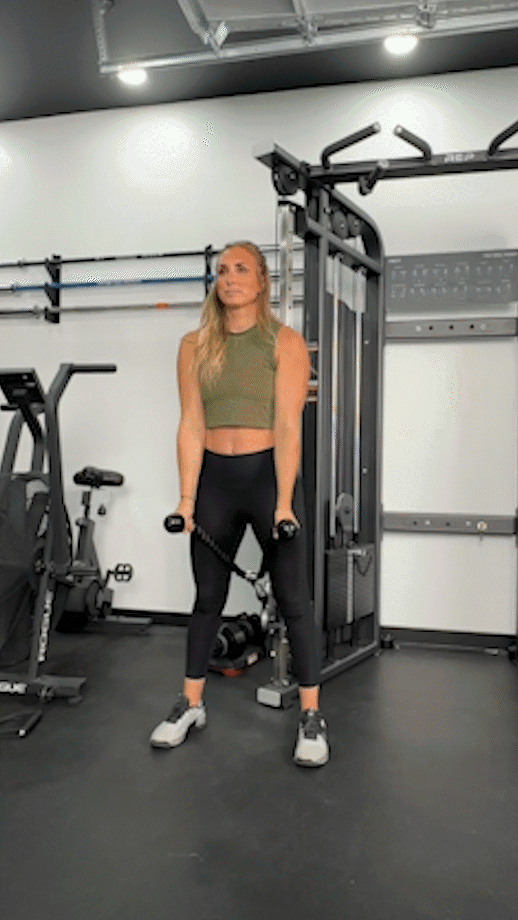
Cable Face Pull
Part of deltoids targeted: Posterior
How to do it:
- Set the pulley to approximately shoulder height, fasten the rope attachment, grab it with an overhand grip, and take a step back, facing the machine.
- Pull the attachment toward your face, splitting off in either direction at the end of the range of motion. Squeeze your shoulder blades together at the end of the movement.
- Pause briefly, then return to the starting position with control.
RELATED: How To Do Face Pulls
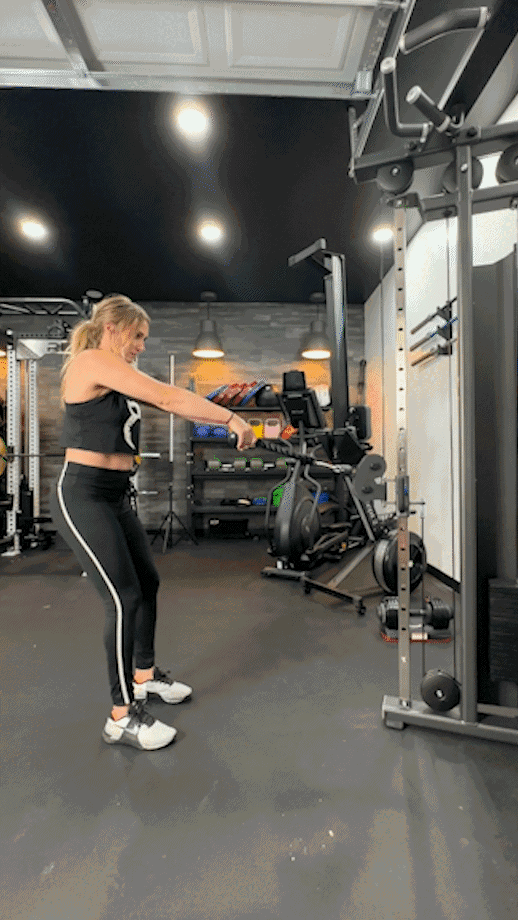
Cable Upright Row
Part of deltoids targeted: Lateral, anterior
How to do it:
- Set the pulley to the lowest position and fasten the attachment of your choice. We prefer the short straight bar, but the narrow grip attachment can work as well.
- Step back into position, facing the machine.
- Pull the attachment to your chin, squeezing your trapezius and delts at the top.
- Slowly bring the attachment back down.
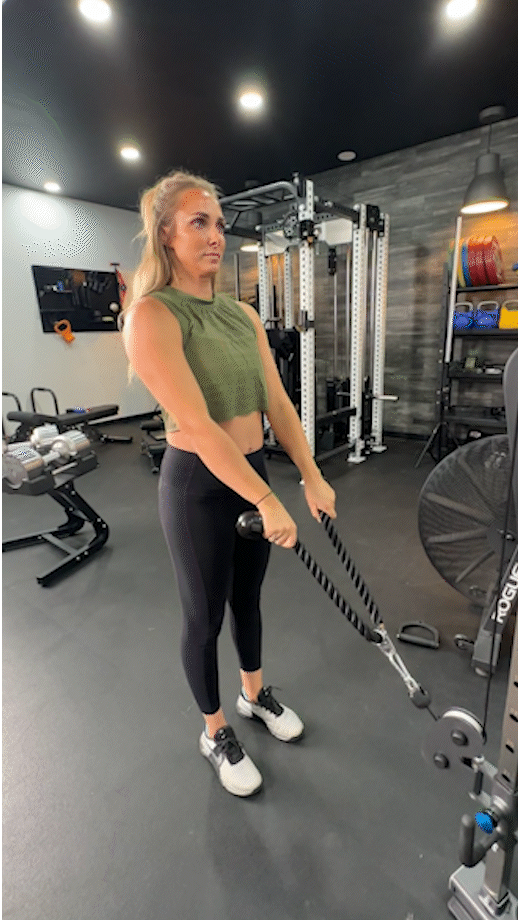
Cable Y Raise
Part of deltoids targeted: Anterior, lateral, posterior
How to do it:
- Set the pulley height to the lowest position, grab a handle with each hand, and step back, facing the machine, to create tension.
- Lift your arms up and away from the midline, creating a “Y” shape. Pinch your shoulder blades together at the end of the motion, then slowly return to the starting position.
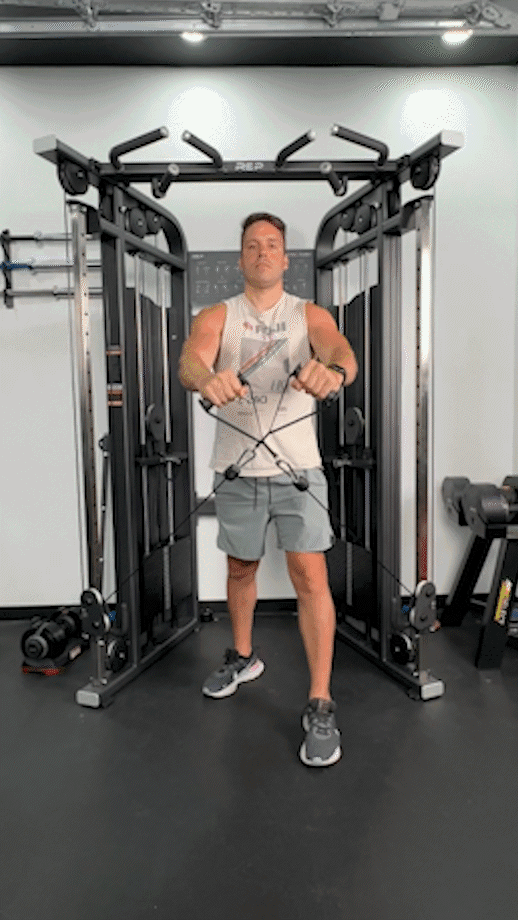
Cable Shrug
Part of deltoids targeted: Lateral, anterior
How to do it:
- Set the pulley to the lowest setting, then attach your preferred attachment. Both the straight bar and rope attachments work well here.
- Grab the attachment with both hands. For the rope attachment, use a neutral grip. For the straight bar, use an overhand grip.
- Take a step back and, with your feet approximately shoulder-width apart, shrug your shoulders, pulling the attachment a short distance. Squeeze your shoulders at the top.
- Slowly return to the starting position.
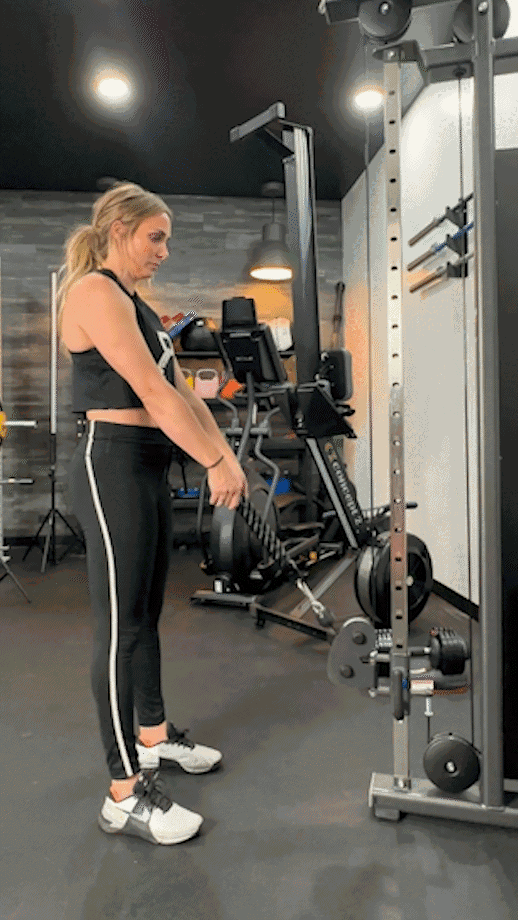
Cable Reverse Fly
Part of deltoids targeted: Posterior
How to do it:
- Set the pulley to chest or shoulder height. Reach across your body so you are grabbing the right handle with your left hand and left handle with your right hand, then take a step back, keeping your arms crossed in front of your chest, to get into position.
- Pull the handles out and away from the midline, keeping a slight bend in the elbow. Squeeze your shoulder blades together at the end of the movement.
- Slowly return to the starting position.
RELATED: How To Do The Reverse Fly Exercise And Why You Should
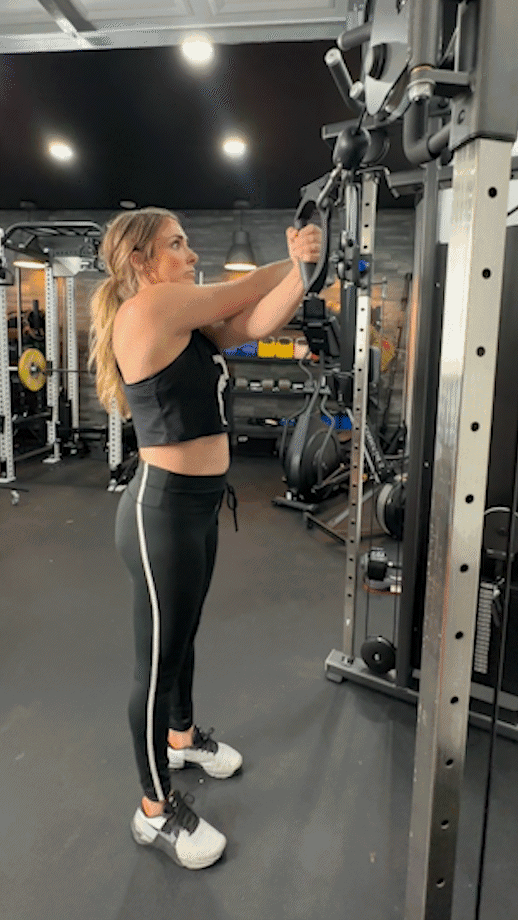
Cable Internal/External Rotation
Part of deltoids targeted: Anterior, posterior
How to do it:
- Set the pulley to elbow height, then grab the handle with your right hand, keeping your right elbow bent at a 90-degree angle and your left shoulder facing the machine, and step away to create tension.
- Slowly rotate your arm, bringing the handle out to the side of the body.
- Slowly return to the starting position, then switch sides and repeat the set.
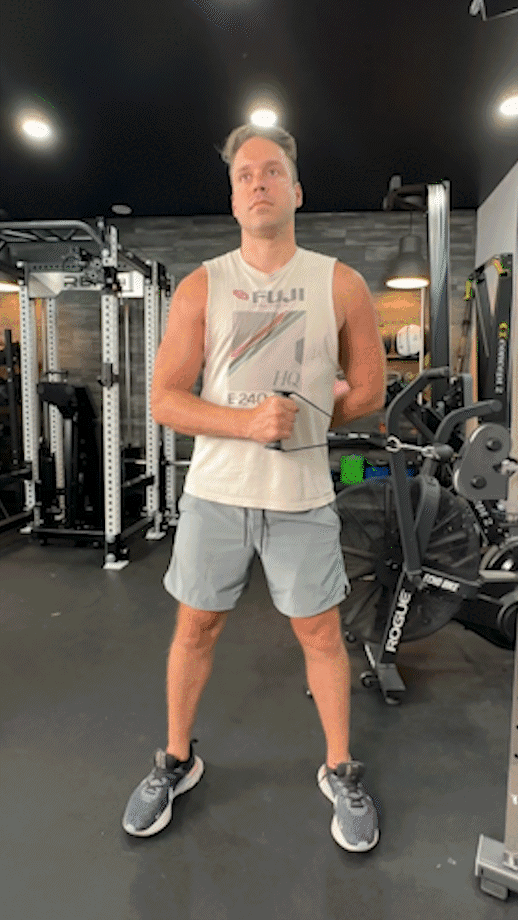
Creating a Cable Shoulder Workout
A list of the best cable shoulder exercises is great, but it’s nothing if we don’t structure it in a way that will provide well-rounded activation to all three heads of the deltoids and get the results we’re looking for.
Kate recommends starting the set with compound exercises like the cable shoulder press, cable crossover, and rear-delt fly, as studies show3 you will get the most benefit from the exercises you do at the beginning of the workout.
After completing the exercises that hit the most muscle groups at once, you’ll want to close out your session with isolation exercises like the single-arm cable lateral raise, front raise, and internal/external rotations.
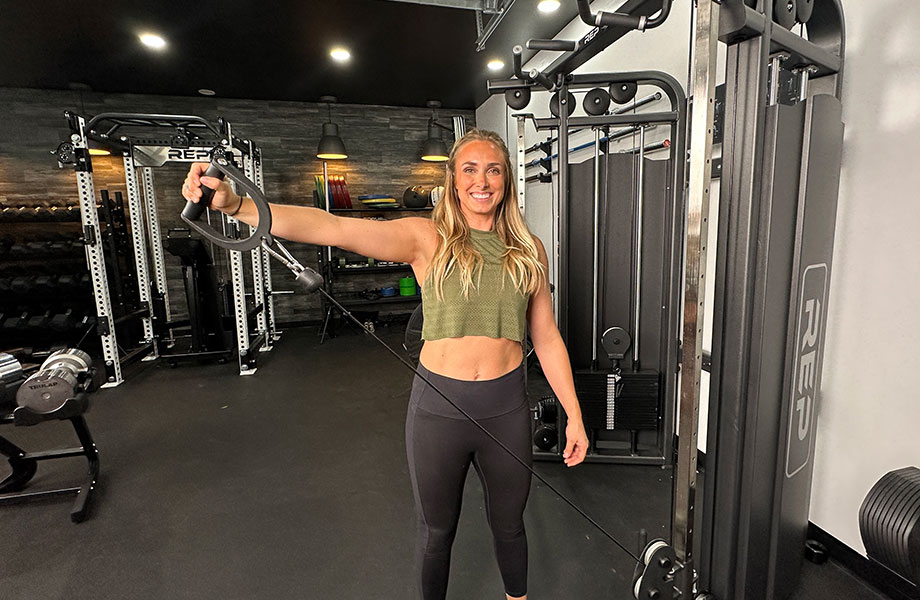
Here’s a sample beginner cable shoulder workout to get you started.
| Exercise | Sets | Reps |
| Cable Shoulder Press | 5 | 5 |
| Cable Crossover | 4 | 8 |
| Cable Reverse Fly | 3 | 12 |
| Cable Front Raise | 3 | 12 |
| Single-Arm Lateral Raise | 3 | 12 |
| Internal/External Rotation | 3 | 12 |
“For the lower-rep sets, go heavy,” says Kate. “Aim to move about 60% to 80% of your one-rep max. Then, for the higher-rep sets, stick to a 40% to 60% effort, really taking your time with the form, squeezing the contract at the peak position, and moving through the eccentric phase slowly and with control.”
You’ll want to rest appropriately during your shoulder session to maximize the effect of each set. Studies show4 that 60 seconds is often sufficient, especially when doing higher rep sets with less effort, but resting three to five minutes between heavy sets could be beneficial, too.
Still unsure? If you’re looking for a tailor-made training plan well-suited to your fitness goals, consider working with a coach, personal trainer, or other qualified fitness professional.
Cable Shoulder Workouts: Final Thoughts
Many different training modalities can help contribute to shoulder muscle growth, strength gains, and improved muscular endurance, but cable machine exercises are an underrated pick to provide incredible activation across all three heads of the deltoids.
Next time you hit the gym, consider trying our cable shoulder workout to switch things up and keep the gains a-coming. Until next time, fitness fam!
Cable Shoulder Workouts: FAQs
Is a cable machine enough to get big shoulders?
When it comes to exercise, cable machine exercises will work wonders for muscle size, strength, and endurance.
A 2017 study published in the Journal of Strength and Conditioning Research5 determined that cable machines offer superior muscle activation and kinematics compared to selectorized weight training machines, showing it’s indeed a viable modality for getting results.
Exercise isn’t the only component to building muscle, however. Support your success by eating right, staying hydrated, taking the best supplements for muscle growth, and getting enough sleep.
Are cables or free weights better for shoulders?
Free weight exercises appear more popular than cable machine exercises, but is that because they’re better?
Not exactly. Both are methods of performing resistance training, but the main difference between the two is the type of resistance.
Free weights create static resistance; that 15-pound dumbbell feels the same whether you have it in the starting position, end position, or anywhere in between.
Cable machines, on the other hand, apply constant tension, creating dynamic resistance. That means that, even though you have the machine set to a certain level of resistance, it will feel more challenging the further you pull it.
Because they’re two totally different types of resistance, both have a well-deserved spot in any comprehensive training regimen. Neither is inherently better.
How do you train your shoulders with cables?
You can put together an excellent workout by cycling through a handful of delt-targeting exercises like the cable shoulder press, cable upright row, and cable front raise, to name a few. These exercises also make a great addition to any other shoulder or upper-body workout, so feel free to include them in any way that makes sense for your fitness goals.
These statements have not been evaluated by the Food and Drug Administration. This product is not intended to diagnose, treat, cure, or prevent any diseases.
References
- Elzanie A, Varacallo M. Anatomy, Shoulder and Upper Limb, Deltoid Muscle. [Updated 2023 May 8]. In: StatPearls [Internet]. Treasure Island (FL): StatPearls Publishing; 2023 Jan
- Campos YAC, Vianna JM, Guimarães MP, et al. Different Shoulder Exercises Affect the Activation of Deltoid Portions in Resistance-Trained Individuals. J Hum Kinet. 2020;75:5-14. Published 2020 Oct 31. doi:10.2478/hukin-2020-0033
- Simão R, Spineti J, de Salles BF, et al. Influence of exercise order on maximum strength and muscle thickness in untrained men. J Sports Sci Med. 2010;9(1):1-7. Published 2010 Mar 1.
- de Salles BF, Simão R, Miranda F, Novaes Jda S, Lemos A, Willardson JM. Rest interval between sets in strength training. Sports Med. 2009;39(9):765-777. doi:10.2165/11315230-000000000-00000
- Signorile JF, Rendos NK, Heredia Vargas HH, et al. Differences in Muscle Activation and Kinematics Between Cable-Based and Selectorized Weight Training. J Strength Cond Res. 2017;31(2):313-322. doi:10.1519/JSC.0000000000001493
Further reading

Find out if we’d recommend this post-workout protein supplement in our MusclePharm Combat protein powder review. Read more

Many lifters and fitness enthusiasts alike strive to build muscle, strength, and stability in their shoulders. The most popular way involves performing repetitions of shoulder exercises with free weights, like barbells, dumbbells, and kettlebells, to provide activation and inspire hypertrophy.Don’t get us wrong; free weights are totally a viable way to sculpt powerful delts, traps, and other upper body muscles, but it’s not the only way.The cable machine offers an abundance of movements that’ll spruce up your workout routine. » Read more about: These Cable Shoulder Workouts Will Fire Up Your Delts » Read more

Are you looking to build a superhero bod? Check out the Chris Hemsworth workout routine, and you, too, could build an Avengers-worthy physique! Read more

In our Genius Pre-Workout Review, a nutrition coach breaks down the ingredients and supplement facts. Read more

